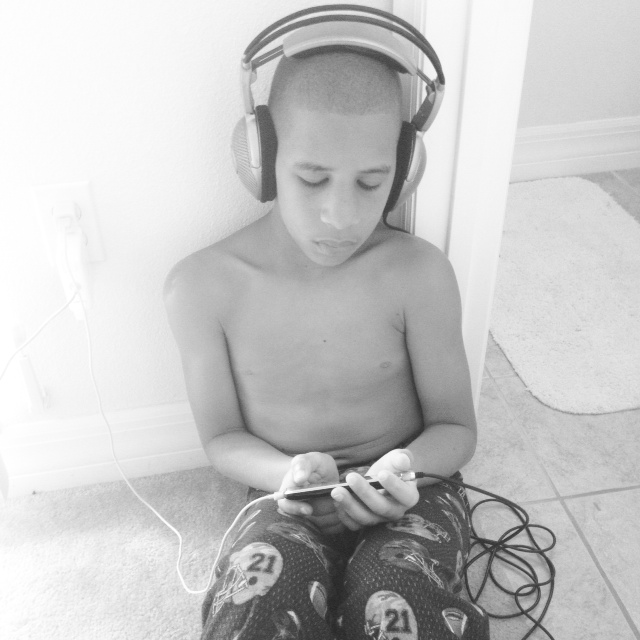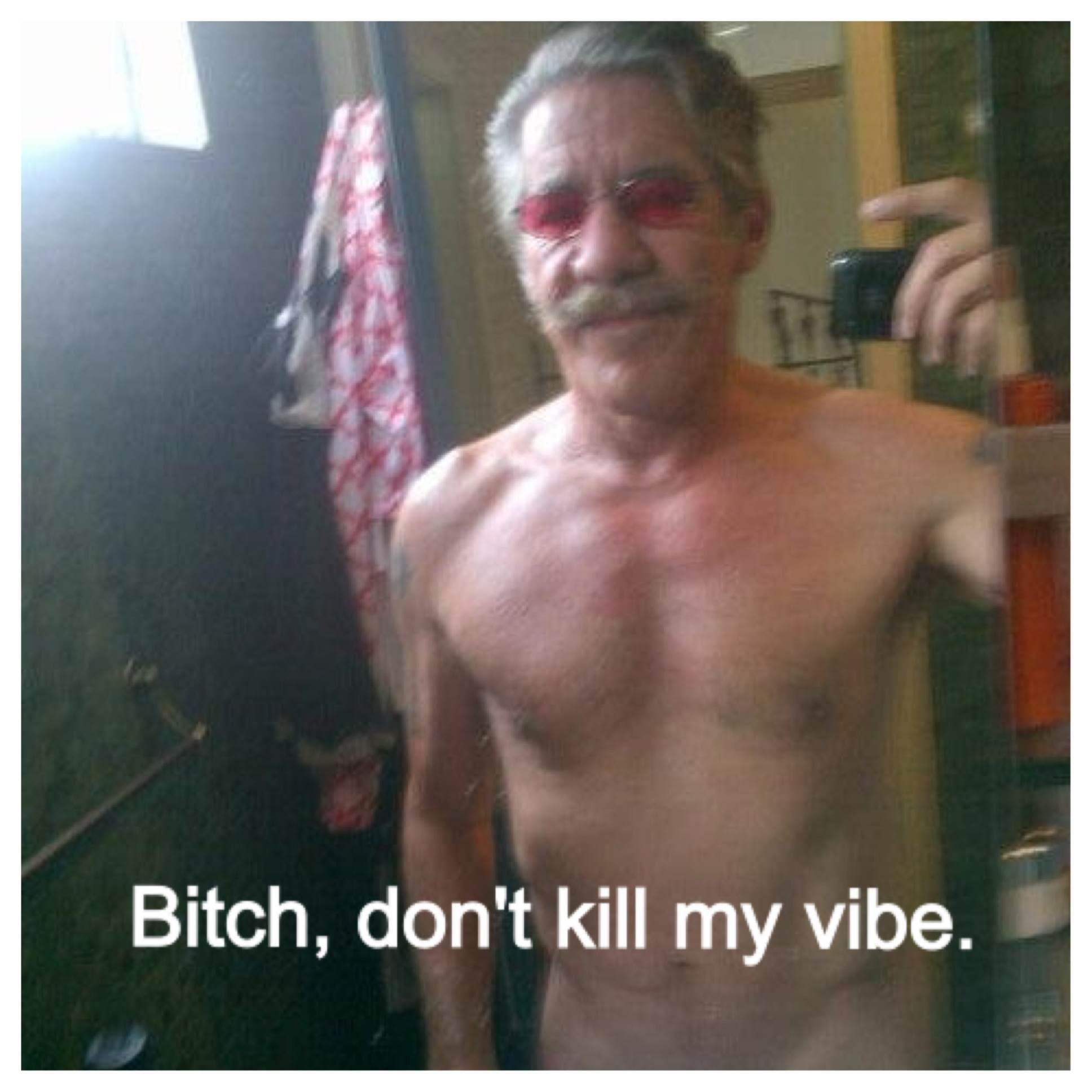Fieldnotes 2: "In New York City, you have to make your own space"
 The following are excerpts from my fieldnotes describing a recent site visit. The names have been changed to protect privacy.
The following are excerpts from my fieldnotes describing a recent site visit. The names have been changed to protect privacy.
Excerpt 1
Roughly 45-minutes into the three hour visit, I noticed something interesting happening. This wasn’t anything I hadn't seen or read about before. It was certainly an instance that I’ve witness emerge inside and outside of classroom spaces, at public events, and around the dinner table. As Chad, a frequent customer at the cafe, talked to me, I noticed behind the counter that Ethan, Ben, and another young man who worked there were all hunched over their cell phones. iPhones, to be exact.
“Yo, you didn’t tag me, son!” Ethan said to Ben. There weren’t any customers in the cafe at this point. Ethan and Ben, while sitting behind the counter, were looking at their phones toggling through Instagram photos.
“Yo, she is ugly, son!” Ethan said to Ben, laughing. Chad looked up from our conversation and asked who they were looking at.
“That’s wifey.” Ethan responded looking at the iPhone screen.
“His wifey is ugly? How’s that?” Chad asked.
“No, no,” Ethan replied, “We looking at another picture now.”
If the cafe was a gendered space, it couldn’t be anymore masculinist than it was at this particular moment. This is what being in a barbershop must feel like, I thought to myself. I was the only woman in the space but that didn’t stop Ethan, Ben, and Chad from exchanging banter about pics of girls and women they gawked at on Instagram. These were light moments between Ethan, Ben, and Chad. I didn’t interject.
Later in the conversation, I asked Ethan and Ben if they were on Twitter.
“Nah,” replied Ethan.
They preferred Instagram along with a new Instagram-like application called Shots.
“Twitter is for females.” Chad interjected. “It’s gossipy, you know?”
“And Instagram isn’t?” I responded. (I had to.)
“Instagram is messy, but not gossipy like Twitter.” Chad replied.
We spent the next fifteen minutes talking about Twitter, Instagram, and then Facebook--which everyone, even me, seemed to agree was wack.
“People break up over Facebook, yo!” Ethan announced.
He told me about the time his girlfriend saw that he liked another girl’s picture on Instagram.
“I was liking this girl's pic to get more followers. It’s like promotion.” He said.
When Ethan's girlfriend found out that he was liking other girl's pictures on Instagram, she ended the relationship.
“I didn’t even do nothing!” He said.
Ben, who at this point I’ve dubbed the quiet one (relative to Ethan), asked if I was on Instagram. I told him I was, but that my account is private. I told him that I’m more active on Twitter. It’s where I get my news.
“Twitter used to be hot back in the day when it first came out, but not anymore.” Ethan said.
In many ways, I agreed with him. Twitter is a much more difficult space to navigate these days than in previous years. But perhaps so is social media in general.
Ethan showed me a picture of him on Instagram when he was 15-years-old. Ben posted the photo but forgot to tag Ethan. If Ethan wasn’t sitting directly next to Ben while they were scrolling through pictures, he probably wouldn't have noticed that Ben didn’t tag him.
“Can I take a picture of you guys while you're looking at your phones?” I asked.
Ethan eyes lit up. “Yes! You gonna put it on Instagram?”
I told Ethan and Ben that I would never post their pictures on Instagram. I also told them that the photos I was taking throughout the day were only going to be used for research.
But Ethan persisted. “You can put [the pic] on Instagram if you want.”
I didn't. Instead, I texted the photos to Ethan's cell phone.
These young men, although labeled disconnected at one point in their lives, were anything but. They moved about in the physical space of the cafe. They also moved about in the virtual spaces of social media. Their bodies, identities, and constructs moved fluidly across time and space. Sociality manifested as mobilities within and among physical, virtual, online, and offline spaces (or places?). These movements, constructs, activities, or whatever you call it were indicative of two very connected and co-present people.
Ethan and Ben's iPhones played significant roles in how connection was established and maintained. These objects, in other words, sustained connection. They also remained in Ethan and Ben's pockets the entire time while they served customers coffee and food.
Yet, Ethan and Ben clearly chose when and where to connect. While they sat in the physical space of the cafe--a constant, sustaining, and perhaps even safe place--the virtual spaces they participated in via their iPhones were not on equal footing. To Ethan and Ben, the spaces that constitute social media held different meanings about their interactions with other people.
Excerpt 2
Later on that day, Patrick, a white guy and regular customer arrived. He playfully argued with Ethan saying that Samsung makes better phones and electronics than does Apple. Ethan wasn’t hearing it though. He, and I too, pointed out how the Apple brand is much more sophisticated than Samsung.
"But, then again," I interjected, “neither Apple nor Samsung are paying my bills so for me it’s not that serious.” I said this while pulling out my iPad Air to check my email.
The banter continued. It was a lovely indication and reminder that there was community here, and it was alive, emerging, and always-becoming.
The topic of conversation shifted. I found out that Patrick was once a middle school teacher. He lived in the neighborhood. Patrick talked about once working in rural North Carolina. He loved the students but hated the parents. He chose to quit teaching once he realized he wasn’t being supported.
Patrick then talked about how it was too expensive to live in Bed-Stuy.
“You can’t find a studio in this neighborhood for less than $1100,” he said.
“Shit, if that!” Chad interjected.
Patrick continued, “The Hassidics are buying up the blocks around here. Then, you know what they do? They rent out rooms. Not apartments. Rooms! You end up living in a shoebox for thousands of dollars.”
“Yeah, that’s pretty crazy” I replied.
“In New York City, you have to make your own space,” Patrick said.
Space, an enigmatic concept, seems to facilitate and impede connection all at once, doesn't it? How then do we make spaces when, in our own lives, space is so obviously scarce, devalued, contested, and always-becoming?
Fieldnotes 1: First Site Visit
(Source)
The following are excerpts from my field notes describing a recent site visit. The names have been changed to protect privacy.
Excerpt 1
I approached the counter where I saw two young Black men standing behind the food preparation station making fruit drinks and coffee. As I waited for one of the young men to take my order, I looked around the Cafe and saw pinned to the wall several Polaroid photos. In all of the photos appeared Father Tim posing with who I assumed were famous people that visited the Cafe conveniently located in the Brooklyn neighborhood made famous by its native son, Shawn “Jay Z” Carter. Just a few blocks north of the Cafe stood Marcy Projects, the once home of the now uber famous Brooklyn rapper.
As I stood there gazing at the photos, Juan, who accompanied me to the site visit, tapped me on the shoulder and pointed to a giant framed photo of Jay Z sitting with his hands folded and looking off into the distance somewhere. I thought maybe the photographer caught Jay Z thinking about how far he’d come since Marcy. On the upper left hand side of the photo was Jay Z’s autograph scribbled in blue. The photo was a prominent fixture in the Cafe. It hung directly across from the young Black man preparing my coffee.
(Source)
Excerpt 2
After our chat, Father Tim and I walked out of the Cafe to meet back up with Juan who was standing outside waiting for us. We talked outside for another hour. We chatted about the neighborhood and the serious social issues facing young Black and brown men. We laughed too.
“Is Harlem turning white like Brooklyn?” Father Tim asked.
He was aware not only of the economic issues facing his neighborhood but also of the racial demographics affecting the entire New York City metropolitan area. Here, I thought, was this Irish priest lamenting about white gentrification, and mincing no words.
He got it.
Three-thirty approached, and if I was ever going to make it back to Harlem by 5 o’clock, I had to prepare for my trek back uptown. We said our goodbyes and Juan and I headed for the G train.
I left the Cafe feeling like I made a new friend, and reassured that a community would have me.
Why vine is a perfect medium for comedy
Two words: Jump cut
In film, the jump cut, or abrupt transition from one frame to the next, functions like a quick, confusing, and incongruous utterance. The viewer is required to fill in the missing rationale or logic, although she doesn't realize it. In humor theory, incongruity theory describes "laughter in response to a perception of incongruity." The jump cut evokes humor, as seen on Vine, the popular short video mobile app with a growing number of aspiring and established comedians.
Because Vine is a short 6-second video platform that allows the user to manipulate time and space by pausing and dragging a scroll bar on a mobile screen, it's the perfect medium to evoke humor through incongruous--or (also conceptualized as) bizarre, queer, inappropriate, odd, discordant, contrasting, "ridiculous" imagery.
The jump cut transition, along with the cutaway is oftentimes a meta comedic device also found in the popular animated sitcom Family Guy.
So there you have it: The medium, in this case, Vine, is the message, humor.
https://vine.co/v/hL9nHAZrt5W
Aging in the Age of the Selfie #TheSelfieProject
Looking at the lines on my face
through the iPhone lens
Drawn deeper, longer.
The curls on my head
lie heavy, grey.
Taking up the screen.
They move on their own now.
The camera's filter can't seem to catch a
glimpse of daddy's and mommy's face
in mine.
I am my own woman now.
My eyes appear
calm and dark.
They smile on their own.
I remember what Audre Lorde wrote in 'Change of Season'
She asks:
"Am I to be cursed forever with becoming somebody else on my way to myself?"
She continues,
"I have paid dearly in time for love I hoarded
unseen
summer goes into my words
and comes out reason."
I am trying to capture a sense of time in this selfie.
Still
unsure
where to locate change
on a digital
and aging face.
#TheSelfieProject
My Selfie Project on Instagram
 The Selfie Project is a social media experiment I started on Instagram in order to communicate out of a need to (be) love(d). The project's mission is inspired by the Abbot, a character in Carl Sagan's novel Contact.
The Selfie Project is a social media experiment I started on Instagram in order to communicate out of a need to (be) love(d). The project's mission is inspired by the Abbot, a character in Carl Sagan's novel Contact.
The Abbot asks, "But why do we communicate? [...] Why do we wish to exchange information?" The Abbot concludes, "I believe that we communicate out of love or compassion."
The selfie (a picture taken of yourself with the intent to upload to social media) has become a cultural phenomenon and social practice that reflects a desire to author ourselves while living and being in an era of complicated and intrusive privacy and surveillance practices, all while the body and self image are perpetually scrutinized.
Does narcissism play a role? Perhaps. But that's not my focus here.
Instead, I understand that through the selfie we seek to reach out to others, confront our mortality through digital reflections, and expose pieces of who we believe we are through the mobile self portrait. The selfie becomes a communicative means through which we articulate identity, emotions, and desire. And yes, the selfie, as practice, can be an exercise of self-deprecation.
With the Selfie Project, I attempt to show that there is more to the selfie than the self. Accompanied by poetry, song lyrics and thoughts, there's you.
This is my love story.
Request to follow me on Instagram @Friday025
#TheSelfieProject






